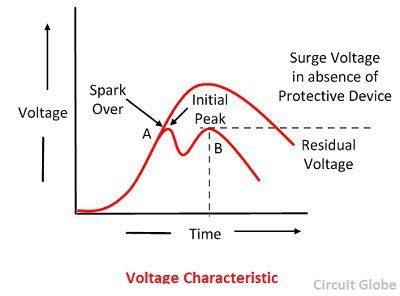Definition: The device which is used for the protection of the equipment at the substations against travelling waves, such type of device is called lightning arrester or surge diverter. In other words, lightning arrester diverts the abnormals high voltage to the ground without affecting the continuity of supply. It is connected between the line and earth, i.e., in parallel with the equipment to be protected at the substation.
The following are the damages that are caused by the travelling wave on the substation equipment.
- The high peak or crest voltage of the surge may cause flash-over in the internal winding thereby spoil the winding insulation.
- The steep wave fronts of the surges may cause external flashover between the terminal of the transformer.
- The highest peak voltage of the surge may cause external flashover, between the terminal of the electrical equipment which may result in damage to the insulator.
Working of Lightning Arrester
When a travelling wave reaches the arrestor, its sparks over at a certain prefixed voltage as shown in the figure below. The arrestor provides a conducting path to the waves of relatively low impedance between the line and the ground. The surge impedance of the line restricts the amplitude of current flowing to ground.
The lightning arrester provides a path of low impedance only when the travelling surge reaches the surge diverter, neither before it nor after it. The insulation of the equipment can be protected if the shape of the voltage and current at the diverter terminal is similar to the shape shown below.
An ideal lightning arrester should have the following characteristics;
- It should not draw any current during normal operating condition, i.e., it sparks-over voltage must be above the normal or abnormal power frequency that may occur in the system.
- Any transient abnormal voltage above the breakdown value must cause it to break down as quickly as possible so that it may provide a conducting path to ground.
- When the breakdown has taken place, it should be capable of carrying the resulting discharge current without getting damaged itself and without the voltage across it exceeding the breakdown value.
- The power frequency current following the breakdown must be interrupted as soon as the transient voltage has fallen below the breakdown value.
There are many types of lightning arrester which are used to protect the power system. The choices of the lightning arrester depend on the factor like, voltage and frequency of the line, cost, weather condition and reliability.
Location of Lightning Arrester
The lightning arrester is located close to the equipment that is to be protected. They are usually connected between phase and ground in an AC system and pole and ground in case of the DC system. In an AC system, separate arrester is provided for each phase.
In an extra-high voltage AC system the surge diverter is used to protect the generators, transformers, bus bars, lines, circuit breakers, etc. In HVDC system the arrester is used to protect the buses, valves converter units reactors, filter, etc.



What is the radius of lighting arrestor.
1.5cm
Thanks for sharing useful information with us.. Its really helpful to me..I always prefer to read the quality content and this thing I found in your post. thanks for sharing with us..
great article
Nice article
Nice information
Very useful articles